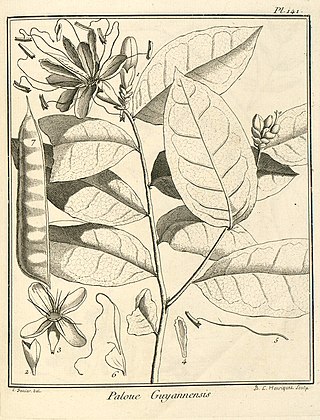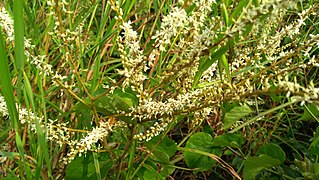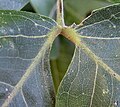
The subfamily Detarioideae is one of the subdivisions of the plant family Fabaceae (legumes). This subfamily includes many tropical trees, some of which are used for timber or have ecological importance. The subfamily consists of 84 genera, most of which are native to Africa and Asia. Pride of Burma and tamarind are two of the most notable species in Detarioideae. It has the following clade-based definition:
The most inclusive crown clade containing Goniorrhachis marginataTaub. and Aphanocalyx cynometroidesOliv., but not Cercis canadensisL., Duparquetia orchidaceaBaill., or Bobgunnia fistuloides(Harms) J. H. Kirkbr. & Wiersema.

Anthonotha is a genus within the subfamily Detarioideae of the plant family Fabaceae.

Gilbertiodendron is a genus of legume in the family Fabaceae. It consists of about 25 species of tree native to west and west-central tropical Africa. Members of this genus were formerly considered to be in the genus Macrolobium but that genus is now restricted to species growing in tropical America. It is closely related to Pellegriniodendron.

Hymenostegia is a genus of flowering plants in the family Fabaceae. It includes 14 species native to west and west-central tropical Africa.
Talbotiella is a genus of flowering plants in the family Fabaceae. It includes 9 species native to west-central and west tropical Africa. Most species ranges from Ghana to the Republic of the Congo. Five are endemic to Cameroon. T. cheekii is endemic to Guinea.

Cercidoideae is a subfamily in the pea family, Fabaceae. Well-known members include Cercis (redbuds), including species widely cultivated as ornamental trees in the United States and Europe, Bauhinia, widely cultivated as an ornamental tree in tropical Asia, and Tylosema, a semi-woody genus of Africa. The subfamily occupies a basal position within the Fabaceae and is supported as monophyletic in many molecular phylogenies. At the 6th International Legume Conference, the Legume Phylogeny Working Group proposed elevating the tribe Cercidae to the level of subfamily within the Leguminosae (Fabaceae). The consensus agreed to the change, which was fully implemented in 2017. It has the following clade-based definition:
The most inclusive crown clade containing Cercis canadensisL. and Bauhinia divaricataL. but not Poeppigia proceraC.Presl, Duparquetia orchidaceaBaill., or Bobgunnia fistuloides(Harms) J.H.Kirkbr. & Wiersema.
Aphanocalyx is a genus of flowering plants in the family Fabaceae. It belongs to the subfamily Detarioideae. It includes 14 species native to tropical Africa, ranging from Sierra Leone to Côte d'Ivoire, and from Cameroon to Angola and Tanzania.

Paloue is a genus of flowering plants in the family Fabaceae. It belongs to the subfamily Detarioideae. The genera was first created with the description of Paloue guianensis by Aublet in 1775.
Berlinia korupensis is a species of tree up to 42 m tall and 88 cm in diameter, belonging to the Senna subfamily Caesalpinioideae of the Bean Family, and is endemic to the Korup National Park in Cameroon, West Africa. Having produced large, delicate white flowers remindful of Bauhinia, the species' seed pods can grow to be 30 cm long. Seed dispersal is explosive with the opposing halves of the pods tightening as they dry until suddenly they split and shoot seeds for a distance that can be as great as 50 metres. It is on the Critically Endangered list as thus far only 17 trees have been found. This is a very recent discovery, having been unknown to the outside world prior to June of 2010.
Lasiobema was a genus of flowering plants in the legume family, Fabaceae, most of which are lianas, belonging to the subfamily Cercidoideae. It was recently (2010) synonymized with Phanera on the basis of morphology, although this was questioned and it can be treated as a section of this genus.

Phanera is a genus of flowering plants in the legume subfamily Cercidoideae and the tribe Bauhinieae. This genus differs from Bauhinia in being vines or lianas, generally with tendrils and a lobed rather than spathaceous calyx, and from Schnella in having only three fertile stamens rather than ten, and being native to the Indomalayan realm and the Australasian realm rather than the Americas. The subsection Corymbosae was recently segregated into a new genus, Cheniella. It has been suggested that the genus Lasiobema should be reduced to a section within Phanera.

Schnella is a genus of flowering plants in the legume family, Fabaceae. It belongs to the subfamily Cercidoideae. All of its species are neotropical lianas.

Mezoneuron is a genus of flowering plants in the legume family, Fabaceae. It belongs to the subfamily Caesalpinioideae and the tribe Caesalpinieae.
Phanera curtisii is a species of 'monkey ladder' lianas in the subfamily Cercidoideae and the tribe Bauhinieae, the genus having been separated from Bauhinia and the defunct genus Lasiobema. Under its synonym Bauhinia curtisii, records exist from Indochina and Malesia;.

Phanera scandens is a species of 'monkey ladder' lianas in the subfamily Cercidoideae and the tribe Bauhinieae, the genus having been separated from Bauhinia and the discontinued genus Lasiobema. Under its synonym, Bauhinia scandens, records exist from the Indian subcontinent, Indo-China and Malesia. Under the name Bauhinia scandens var. horsfieldii its Vietnamese name is móng bò leo.
Phanera cardinalis is a species of lianas in the subfamily Cercidoideae and the tribe Bauhinieae, the genus having been separated from Bauhinia and also placed in the defunct genus Lasiobema. Under its synonym, Bauhinia cardinalis, records exist from Vietnam, where it is called móng bò đỏ, mấu hang or mấu tràm; no subspecies were listed in the Catalogue of Life.

Cheniella is a genus of flowering plants in the legume family, Fabaceae. It belongs to the subfamily Cercidoideae. It includes ten species which range from the eastern Himalayas through Indochina and China to Taiwan, Peninsular Malaysia, Sumatra, and Java. This genus differs from Phanera in having a hypanthium that is equal in length or longer than the sepals, indehiscent fruit, many-seeded fruit, and the funicle extending most of the circumference of the seed.
Phanera saigonensis is a species of lianas in the subfamily Cercidoideae and the tribe Bauhinieae, the genus having been separated from Bauhinia. Under its synonym Bauhinia saïgonensis, records exist from the tropical forests Indochina only.
Phanera ornata is a species of lianas in the subfamily Cercidoideae and the tribe Bauhinieae, the genus having been separated from Bauhinia. Under its synonym, Bauhinia ornata, its Vietnamese name is "móng bò diện". Distribution records exist from Assam, S. China and Indochina, where wild plants grow primarily in the tropical forest biome.

















